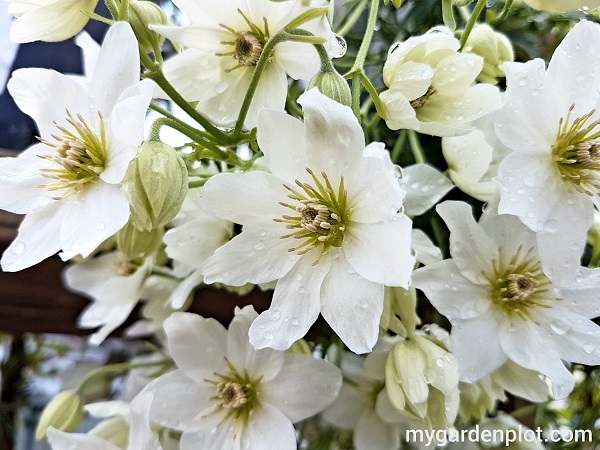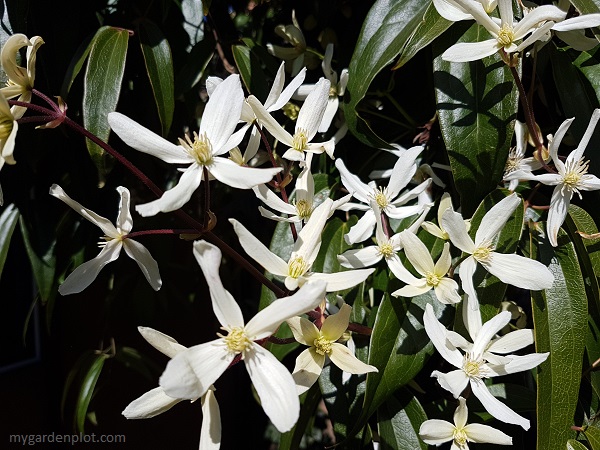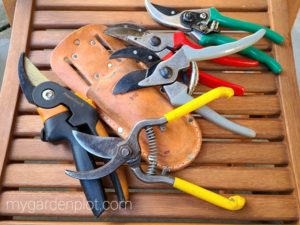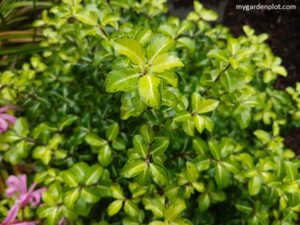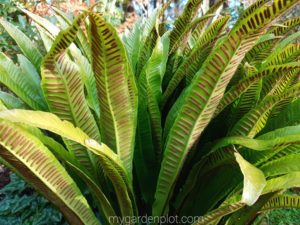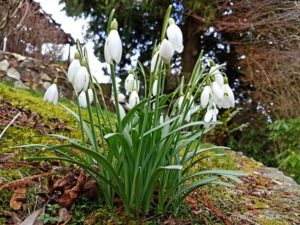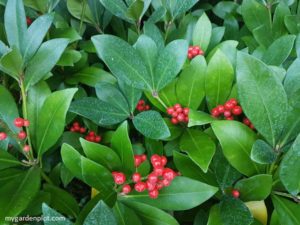The C. armandii is also known as the Armand clematis vine
The evergreen Clematis armandii, also known as Armand clematis, is native to the warmer regions of China and northern Myanmar (Burma). Placed in the right location, this fragrant flowering clematis vine is a welcomed sight in spring (blooming March and April in our region of the Pacific Northwest). Most of the year, its glossy evergreen leaves add year-round foliage in a sheltered and partly sunny area. Loved by so many gardeners, it is often planted in a location where it can be viewed easily from inside the home or at an entrance. This vine does well in a partly sunny and sheltered area. Learn when and where to plant, and how to care and prune evergreen clematis armandii.
The evergreen clematis is in Group A (or group one) classification which includes those clematis species and their cultivars that flower in early spring, including this evergreen species. Hands down, this is one of our favourite evergreen vines!
Supporting Structure For Evergreen Clematis
The clematis armandii with its hanging branches trailing from a pergola adorned with an abundance of white, fragrant flowers, is just spectacular. It is a vine that drapes itself and needs a sturdy support such as a wall or pergola, or any structure, even a fence or over an archway would look beautiful.
When trained over a passageway, the medium-sized flowers add a touch of romance, while the vine trailing and lightly swaying in the breeze add a sense of peace. This is our patio view set against a backdrop in the early morning sunshine. It is a wonderful way to enjoy that first cup of coffee.
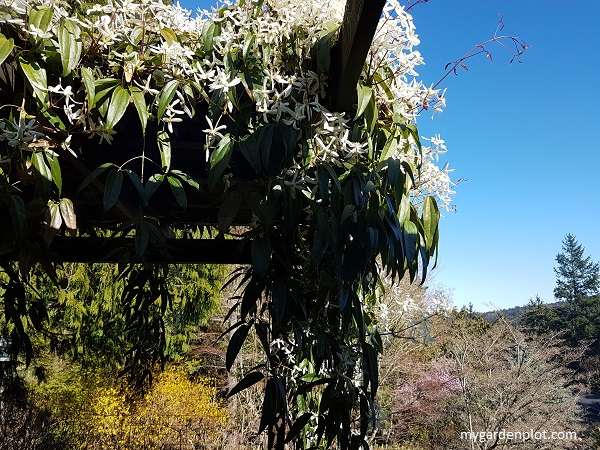
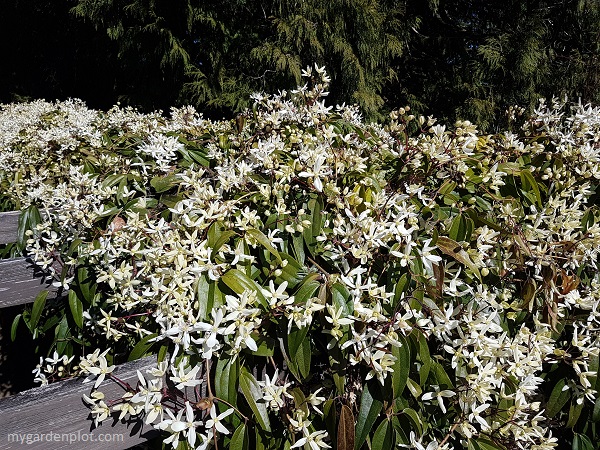
Recommended Ties And Support Structures
For ties we prefer to use velcro ties for support with younger evergreen clematis vine; they are reusable, secure but, better yet, gentle on young stems where needed. For more robust support, we use flexible wire ties that are covered with a soft covering. Particularly for our mature evergreen clematis, we need to use the flexible wire ties on stems to remain positioned for a long time. Easy to remove if we need it but strong enough to last a long time.
Evergreen Clematis armandii At A Glance
Type: Evergreen perennial
Location: Part sun / part shade
Blooming season: Spring
Height and spread: Can reach up to 10 metres (33 ft)
When To Prune: Late Spring / Early Summer
Cold Hardiness Zones: 6, 7, 8, 9
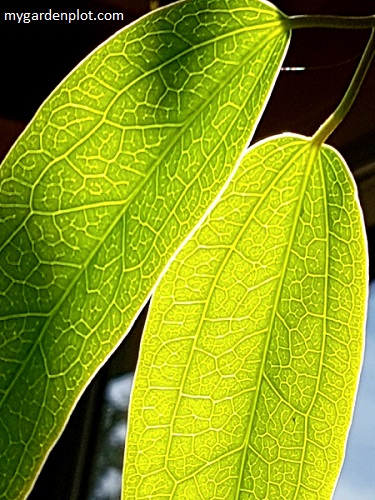
When And Where to Plant Clematis armandii
The evergreen clematis C. armandii likes humus-rich, moist, well-drained soil. When planting, make sure the soil in the immediate area is loosen if it is compact. Mix organic compost or bone meal to the soil. The best time to plant an evergreen clematis is during the spring months. Planting can also be done in the summer subject that all the conditions are flavourable. In the Pacific Northwest, we can also plant in the autumn time. It is fairly hardy but in colder regions plant your evergreen clematis in a sheltered location, protected from cold winter winds.
Due to its growth pattern, the vine should be planted along with a supporting structure like a fence, pergola or gazebo. It is a fast-growing climber and can reach 10 metres (over 30 feet). And as an evergreen, the C. armandii is also perfect as coverage of large walled area. Keep in mind that this location must have moist, well-drained soil. If the walled area sits in a south location where it draws heat from the sun it may dry the soil to much during the hot summer months. It will be challenging to keep it alive.
My evergreen clematis is planted facing east and thrives in a sunny location where it drapes the pergola receiving sun all day and shading the patio below it. While at the same time, its roots are kept cool on the east-facing slope shaded by rhododendrons and azalea
How to Care For Clematis armandii
The Clematis armandii benefits from annual feeding and mulching. Fertilize late winter or early spring before new growth begins with a balanced fertilizer. Mulch, especially rich organic mulch, placed around the plant area will not only feed the vine but provide additional shade for its roots and retain moisture in the soil. Care needs to be taken to much place mulch up against the stem of the plant. Water regularly and ensure the soil does not dry out completely during the summer months.
When And How To Prune Clematis armandii
Aside from a light trim, this easy-care climber is low maintenance. If necessary to train or control the growth it is best to prune after flowering in late spring or early summer.
Evergreen clematis are vigorous growers and need considerable space to thrive. Don’t let your C. armandii go too many years without a light prune, which helps to keep it under control and tidy.
Remember that the C. armandii flower on previous year’s growth. Excessive removal of old wood will bring a loss of flowers the following season.
Tools Needed For Pruning Your Evergreen Clematis
Below is the list of essential tools needed to prune any of the three clematis groups. Regular annual pruning helps reduce size and encourage a healthy growth habit and blossoms:
- Pruners – Bypass pruners are the most popular choice for gardeners and a must in a pruner’s tool kit. Bypass means the blades pass each other in a scissor-like action providing a clean cut without splintering the stem’s edge. The anvil garden pruner, where the upper blade cuts against a lower flat edge, must always be kept sharp. Otherwise, it will crush the stem while trying to cut it.
- Garden Gloves – Gardening gloves help keep hands clean and provide protection. Fabric gloves with vinyl offer a good grip on the fingers and palm. Good for warmer weather. For more challenging jobs, a pair of suede or leather gloves go a long way. Not too comfortable in warmer weather, though.
Buyer's Guide To Hand Pruners (Pruning Shears, Secateurs)
Evergreen 'Cartman Joe' Clematis
The evergreen Clematis × cartmanii ‘Joe’ is another favourite vine of ours. The leaf and smaller flowers are a little more delicate-looking. Just as hardy, this evergreen clematis is spectacular. The general care is the same, but this clematis thrives best in part shade. It is also suitable for container gardening.
